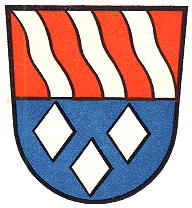Teisbach: Difference between revisions
Jump to navigation
Jump to search
Knorrepoes (talk | contribs) No edit summary |
Knorrepoes (talk | contribs) m (Text replace - "[[Literature" to "{{media}} [[Literature") |
||
| Line 19: | Line 19: | ||
The upper half of the arms shows three wavy bends, symbolising the latter part of the name (Bach=stream, brook). The lower half shows three diamonds, taken from the arms of the medieval Klingpeck family, which was the most influential family in the town in the 16<sup>th</sup> century. | The upper half of the arms shows three wavy bends, symbolising the latter part of the name (Bach=stream, brook). The lower half shows three diamonds, taken from the arms of the medieval Klingpeck family, which was the most influential family in the town in the 16<sup>th</sup> century. | ||
{{media}} | |||
[[Literature]] : Stadler, 1964-1971, 8 volumes; Hupp, O: [[Kaffee Hag albums]], 1920s | [[Literature]] : Stadler, 1964-1971, 8 volumes; Hupp, O: [[Kaffee Hag albums]], 1920s | ||
Revision as of 06:41, 9 July 2014
| Heraldry of the World Civic heraldry of Germany - Deutsche Wappen (Gemeindewappen/Kreiswappen) |
TEISBACH
State : Bayern
District (Kreis) : Dingolfing-Landau (until 1973 Dingolfing)
Incorporated into : 1972 Dingolfing
Official blazon
Origin/meaning
The arms were officially granted on November 14, 1553 by Duke Albrecht V of Bayern.
The upper half of the arms shows three wavy bends, symbolising the latter part of the name (Bach=stream, brook). The lower half shows three diamonds, taken from the arms of the medieval Klingpeck family, which was the most influential family in the town in the 16th century.
Contact and Support
Partners:
Your logo here ?
Contact us
© since 1995, Heraldry of the World, Ralf Hartemink 
Index of the site
Literature : Stadler, 1964-1971, 8 volumes; Hupp, O: Kaffee Hag albums, 1920s











